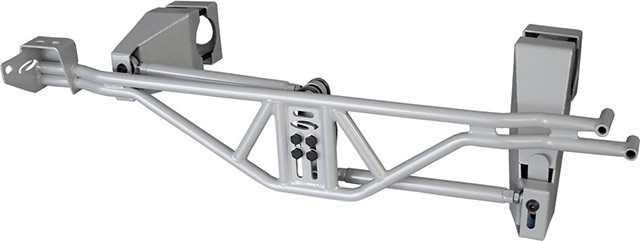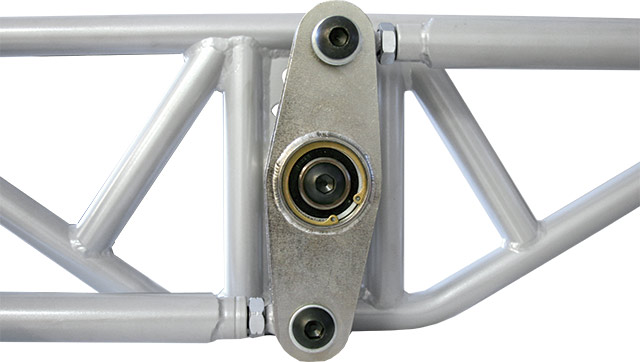Steeda Autosports has the most technologically advanced and best performing suspension upgrade you can provide for your 2005 through current Mustangs - The Steeda Watt's Linkage. Designed, engineered, and manufactured under strict ISO 9001-2008 Certified Procedures, it sets the benchmark for Watt's Linkage suspension systems. When you consider purchasing a Watt's Linkage, do not be fooled by advertising hype into thinking that all Watt's Linkage systems are the same - because they are not. As part of our continuing documentaries on Mustang performance parts, we are going to expose the differences between the Steeda and Brand "X" Watt's Linkages so you, the consumer, can make an intelligent purchase decision.

Background
First - the background on why a Watt's Linkage is far superior to a Panhard Bar suspension. A Watt's Linkage is used as the lateral positioning element in a multi-link suspension where the other links do not provide any (or minimal) lateral positioning. It replaces the Panhard Bar that was added when Ford re-designed the suspension with the 2005 model year and made the trailing arms parallel with the length of the chassis. When all of the trailing arms were made parallel, they no longer provided lateral (side-to-side) positioning by themselves (as they did on the triangulated 4 link design of the Fox/SN95).
What is wrong with a Panhard Bar?
As the axle mount position of a Panhard Bar rises and falls with suspension motion, the axle moves laterally with respect to the chassis due to the arc described by the Panhard Bar's rotation. This, in effect, binds the suspension; preventing it from moving to where load transfer and geometry would like it to be. Therefore, the lower the amount of movement, the better. A perfectly set up Panhard Bar (that is, horizontal at ride height) with a length of 42.5'' (about what the S197 is) has a lateral motion of about 0.189'' (roughly 3/16'') toward the passenger side for 4'' of travel in both bump and rebound. When the Panhard Bar cannot be set up perfectly, the amount of lateral movement increases in either bump or rebound (depending on which end of the Panhard Bar is lower). Further, since the axle moves toward the passenger side in both bump and rebound, there is a different cornering characteristic when turning left vs. right.
Why is a Watt's Linkage better?
A Watt's Linkage nearly eliminates lateral motion in the middle of its operating range. With the lateral and center link lengths that Steeda uses, the lateral motion for 4'' of bump travel is about 0.018'' (roughly 1/64'' or 1/10 of the Panhard bar amount). At 4'' of rebound it is about 0.017'' (again, about 1/64'' or 1/10 of the Panhard bar). At 2'' of bump/rebound travel, the Watt's Linkage is even more impressive. The Panhard Bar has moved 0.047'' while the Watt's Linkage has moved less than 0.001''. This reduced amount of lateral motion allows the suspension to react to cornering forces in a more consistent manner. The wheels will be able to track the road more consistently. From a driver's view, the axle will feel better controlled when encountering a bump or dip during a turn. The rear end will feel more connected and stable to the chassis. Because the lateral movement is near zero, the left vs. right turn dynamics are effectively the same. Another minor point is that since the axle locates consistently between the wheel wells, a slightly larger tire can be used without fear of rubbing the tire.

Why should I buy a Watt's Linkage for my Mustang?
This product is for the most discerning street performance enthusiast and also for those tracking their car. The inherent loose axle feeling with the Panhard Bar (due to lateral axle movement) doesn't always inspire confidence when tossing the car around. The more stable feeling with a Watt's Linkage should allow a typical driver to control the car closer to the vehicle's limit.
Now...The Showdown: Steeda vs. Brand "X"
Now, lets compare the differences - this gets a bit technical at times, but in the details are the key substantial differences between the Steeda and the Brand "X" Watt's Linkages:
1). Axle Mounted versus Chassis Mounted
Simply stated, the Steeda's Watt's link is chassis mounted whereas Brand "X"' is axle mounted. In all Watt's Linkages, the center pivot is the roll center.Chassis-mounted pivots have a consistent distance from the sprung mass to the roll center because the pivot (roll center) moves up and down with thesprung mass. Axle-mounted center pivots have a roll center height that is fixed at some point above the ground. So, as the body moves up and down,the distance between the sprung mass and the roll center will change. The reason that a consistent distance from sprung mass to roll center isimportant is that the sprung mass acts on the suspension through that distance. So, a consistent distance means consistent suspension loading,which leads to consistent tire loading and better overall vehicle handling.
ADVANTAGE: Steeda
2). Adjustability
The Brand "X" unit has 2 positions for the center pivot height and they are approximately less than 3/4" apart. The SteedaWatt's Linkage is continuously
adjustable allowing for an infinite amount of tuning adjustment to match your car's setup, your driving skills, road/course conditions, and the type of driving you are doing.
ADVANTAGE: Steeda
3). Center Pivot Bushing

The Brand "X" uses a synthetic elastomer bushing for the centerpivot. The type of busing they use will, over a prolong period, will deteriorate and show signs of wear due to the extreme forces subjected to it, but more importantly, a bushing of this type it is not as consistent in it's retention characteristics because of it's inherent physical nature (e.g. inherent flexing). The SteedaWatt's linkage uses a pair of expensive rolling-element bearings that are pre-lubricated for extra long-life, and a bearing of this type provides for a consistent level of rotational movement - far superior to just a lower-grade and far less expensive synthetic elastomer bushing.
ADVANTAGE: Steeda
4). Lateral Load Transfer
The Brand "X" unit transfers the lateral loads through the Ford differential housing which was never designed by Ford for this purpose. Brand "X" attaches their Watt's linkage using a purpose built differential cover to the existing mounting points with a gasket between them for sealing. With the gasket between the housing and the cover, and that fact that the attachment bolts cannot be torqued overly tight (usually only 24 - 35 ft. lbs. depending upon model year), the end result is that the differential gasket ends up transferring the load and in time, may be prone to leakage. In the Steeda Watt's Linkage, the transfer of lateral load forces are accomplished into the chassis through a strategically engineered ultra-strong tubular chromoly structure that was purposely designed and engineered for this purpose. Purpose built, ultra-strong, and designed and engineered under strict ISO 9001-2008 certified standards, this is the best methodology one could engineer for the Mustang - bar none!
ADVANTAGE: Steeda
5). Vertical Path
A Watt's link is said, generally, to provide a vertical path for the roll center rather than the C-shaped path of a Panhard bar. This is more-or-less true when, at nominal ride height, the center link is perfectly vertical and the linkage arms are perfectly horizontal. From this position,the roll center path is very, very close to straight-line vertical for some amount of axle travel up and down. In reality, when the entire travel rangeof a Watt's link is plotted, the path that the center pivot takes is actually S-shaped. The length of the center pivot "propeller" and the linkage arms determines how much of the total travel will be vertical. A shorter "propeller" and/or shorter arms cause less vertical travel before the path starts looking S-shaped. The Brand "X" unit has fairly short centerpivot "propeller" which results in fairly short vertical travel capabilities. Whereas the Steeda Watt's linkage has a much longer pivot propeller which inherently provides for the capability of longer vertical travel while still offering vertical roll center location.
ADVANTAGE: Steeda
Why is Steeda's Watt's Linkage better than others?

We started with a "blank sheet"....doing extensive product evaluations and engineering simulations to form a basis for the current suspension dynamics on the Mustang. Then we combined our ISO Certified design process, engineering procedures, and computer animations along with real-world performance track driving sessions with the 2005-present Mustang to re-invent the best Watt's Linkage upgrade possible for your vehicle. The Steeda Watt's Linkage suspension upgrade, the BEST performing suspension upgrade for 2005-current Mustangs - PERIOD.
Steeda - Speed Matters

